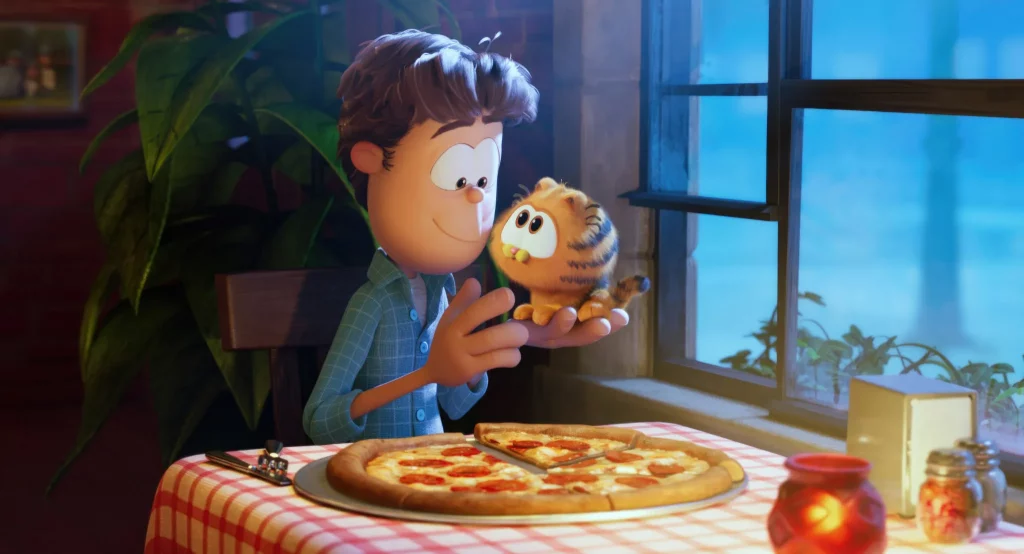Take into account the information that is now available about Garfield the cat: he is orange, rather chubby, adores lasagne, despises Mondays, and — well, that’s about it. Sufficient details to occupy roughly four comic strip panels, isn’t that right? And yet, inexplicably, this slothful cat and his rather insignificant adventures (how to obtain more lasagne, how to sleep through a Monday, etc.) have spawned three feature-length films, a dozen prime-time specials, and three television shows (with another on the way).
The most recent in a long, long line of Garfield adaptations takes a different approach from the previous ones, which stretched his adventures to absurd extremes. For example, the 2004 film “Garfield: The Movie” essentially served as an origin story, while the 2006 follow-up “Garfield: A Tale of Two Kitties” gave his life a “Prince and the Pauper”-esque twist. The gaudily animated “The Garfield Movie” by Mark Dindal, not to be confused with “Garfield: The Movie,” brings a cherished feline character into a film that feels very much apart from what makes Garfield, well, Garfield.

The other movies at least make an effort to cash in on Garfield’s long-standing charm, but Dindal’s debut into the canon—which features a screenplay by no fewer than three screenwriters, including Paul A. Kaplan, Mark Torgrove, and David Reynolds—seems determined to discard the scant information we do have about the chubby cat, at least after its exuberant opening sequences wear off. Before getting into the actual plot of the story, Dindal whips us through all the major moments in the Garfield saga with true fun and speed. He even throws in a small genesis story for the character, complete with the cutest animated orange kitten you’ve ever seen.
Unfortunately, that story feels more like a cheap imitation of “Chicken Run” than a Garfield movie — they break into a dairy! — that some high-ranking Hollywood executive probably believed Jim Davis’ plump orange tabby might inject with a boost. Do any of these things have anything to do with Garfield, this writer would frequently wonder during the running of the movie? At least Kaplan, Torgrove, and Reynolds attempt to make some links, even though certain passages seem lifted straight out of the diaries of that other rash orange tabby cat (Heathcliff, naturally).
There is nothing about this version of Garfield that feels particularly special or unique in the slightest. The titular tabby, voiced by Chris Pratt—who appears to have responded to criticism over his “Super Mario Bros.” casting with some of the laziest voice work in recent memory—arrived in Jon Arbuckle’s (voiced by Nicholas Hoult) life after his tubby father Vic (voiced by Samuel L. Jackson) abandoned him on a stormy and dark night. At a nearby Italian restaurant, baby Garfield goes in search of food and meets a lonely Jon. The two form an immediate (and endearing!) friendship.
Five years later, Garfield is rising to the top of everything. They’ve moved to the suburbs with Jon, where devoted dog Odie serves as Garfield’s “unpaid intern” and no meal is complete without lots of cheese on top. What a bad moment for (checks notes) the evil cat Jinx (voiced by an animated Hannah Waddingham) to have a serious bone to pick with Vic when he kidnaps Garfield and Odie. Evidently, Jinx and Vic were in a gang together (paging Heathcliff) until a dairy heist went horribly wrong and Jinx ended up in the pound while Vic got out unscathed. This is where the youngest viewers of the movie, the ones who will enjoy it the most, will undoubtedly lose their minds.
Her demand was that Vic, Garfield, and Odie steal one quart of milk for every day she spent in the pound in order to make up for the years she lost in the clink. About 1,600 quarts is it. It’s quite a bit. But in order to do this? The group enlists the aid of a cast-off bull named Otto (voiced by Ving Rhames), whose life was turned upside down when some corporate bigwigs purchased his charming small dairy and insisted on throwing him out while clinging to his adorable paramour, Ethel. Indeed, a “eh, why not?” moment occurs when Vic, Garfield, and Odie physically run into Otto in the grounds surrounding Lactose Farms.plan is formed, full of nebulous “Chicken Run” concepts that lack the emotional resonance of that beloved cartoon film.
Not that the movie doesn’t try to put its heart where its mouth is. Although there has never been much concern over Garfield’s ancestry, “The Garfield Movie” attempts to incorporate a poignant tale about dads and sons and how to combine your real family with your new tribe. The film exhibits restraint when it comes to hinting at future adventures involving Garfield’s mother or littermates, which is a small but commendable trait.) There are several high-energy scenes that propel the action forward, such as the “training” montages that revolve around Vic and Garfield’s delight and the recurring joke that Odie is the only one with a brain that never runs out of steam, but the connections between all of these high-octane antics are as weak as a lasagne noodle.
“The Garfield Movie” still struggles to break free from the spotlight of corporate synergy despite those blatant attempts at passion. Since “The Garfield Movie” is a Sony film, viewers won’t likely bat an eye when Garfield subtly installs a pair of obnoxious Sony headphones!-branded headphones on Jon’s head while he sleeps, but it will hurt when the movie starts inserting advertisements for everything from Olive Garden to Walmart into even the most innocent of moments.
Is this a commercial or a children’s film? If the latter, what specifically is the advertisement for? Not any more films like this, for sure. I am already aware of the breadsticks at Olive Garden. I’d like to learn more about the kind of family-friendly aspects that the multiplex sorely lacks—those that are cute, clever, and humorous. Whether it’s Monday syndrome or something else entirely, this cat has to go back to the drawing board.



